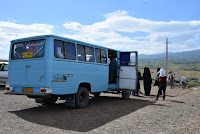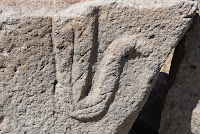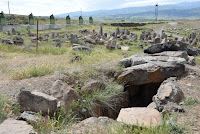To reach the recently discovered archeological site of Sahar Yeri in the mountainous area of Meshkin Shahar we had to walk for about half an hour, which provided us with a completely different type of landscape from the one we had come across before. Snow capped mountains in the distance set the scenario "framing" for the plains where wandering shepherds could be seen from time to time.
Several women sat outside their homes in the inhabitted parts of the pathway leading up to the site but no contact was established once they had a distrustful look and clearly showed they didn't want any talking nor photograph taking. One of them was even aggressive towards a lady in the group.





Upon reaching the site we were approached by a group of schoolgirls on a school bus organised excursion wanting to talk to us, which contrasted with the previous experience.
Sahar Yeri, which has been archeologically discovered in 2005 is believed to be one of the earliest inhabitted places in Iran - around 2,000 years, despite still being thoroughly dated. Covering about 400 hectares it assembles a huge number of up to three metre high and 1 to 1/2 metre wide upright volcanic origin stones with human images on them with quite a few different design representations and some of them holding one or two daggers. Both faces of men and women have no mouths, presumably representing silence.
It is believed these rocks were assembled in such a way for religious ceremonies but scientific investigation is still going on. A number of daggers are said to have been found in several graves around the area which together with quite a few artefacts are now to be found in display at the Museum of Meshkin Shahar.
We spent some time exploring the area with its caves under the direction of a local guide and I must say many of us were impressed. I know I was, as I looked at each of these carved figures almost individually trying to work out whether they were male or female and what life must have been like 2,000 year back.














































No comments:
Post a Comment